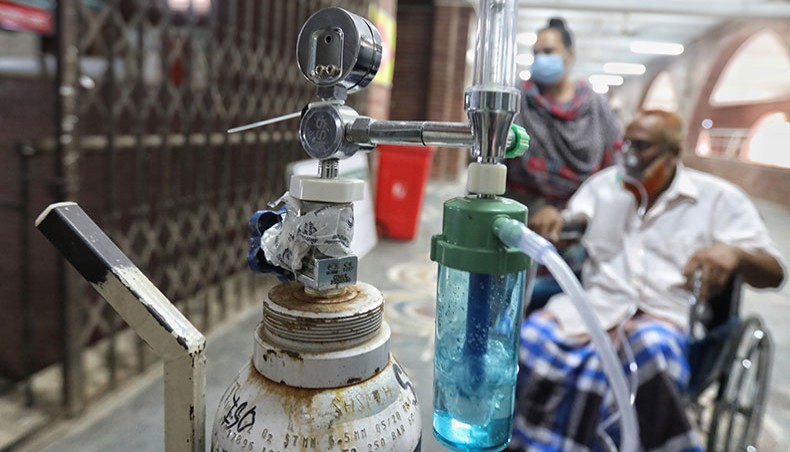
Covid patients from all over BD flood Dhaka hospitals

Dedicated Covid hospitals in the capital are filling up fast with patients pouring from across Bangladesh despite desperate attempts by hospital authorities to release as many patients daily as are admitted.
To keep hospitals from filling up, their authorities over the past month have been taking patients who have needed oxygen support, sending them back home as soon as they have become able to breathe on their own.
Still, the overall proportion of vacant general beds at the 16 government Covid hospitals in the city fell to about 40 per cent on Thursday from 80 per cent on June 1, according to official data.
The government Covid hospitals have 3,807 general beds.
Of the 384 ICU beds, 99 are vacant, according to the official count provided to the media on Thursday, which hospital authorities said an underestimation of the actual situation.
‘All of our 780 beds are now occupied following the daily average admission of 60 patients over the past week,’ Dhaka Medical College Hospital director Brigadier General Md Nazmul Haque told New Age.
The official data given by the Directorate General of Health Services to the media on Thursday showed that 94 general beds were still vacant at the DMCH while the 20 ICU beds at the hospital have been occupied since June 1.
The Dhaka Covid hospitals have taken patients by the dozen or so over the past week as the number of active cases almost doubled to 1,17,081 on Thursday, in less than two weeks, from 68,231 on June 27.
Over the past week Bangladesh has also seen a steeply upward trend in its daily Covid deaths and positivity rate.
About 70 per cent of Covid patients admitted to the city Covid hospitals in the past week were from outside Dhaka, hospital authorities said, warning that the remaining vacancy might exhaust by the next week.
‘Many of the patients were from rural areas and we received them mostly in critical condition,’ said Dhaka North City Corporation Covid Hospital director Brig Gen AKM Nasir Uddin.
The DNCC hospital, he said, is tackling the most critical patients for it is the hospital with the country’s highest 212 ICU beds while there are 500 general beds at the facility with central oxygen supply.
The general beds have been mostly vacant to date with only about 20 patients admitted to the hospital daily, who are mostly critical cases, he explained.
Still, the number of patients admitted to the DNCC Covid hospital rose to 408 on Wednesday from only 65 patients admitted two weeks ago.
The hospital admitted 147 Covid patients on Tuesday and Wednesday, about half of them to its ICU unit, leaving 60 of its ICU beds vacant till then.
‘The way the flow of patients is increasing may exhaust our capacity in the next 10 days,’ said Nasir.
About 30 per cent of patients coming outside of Dhaka are arriving without any test confirming their Covid infection, said the hospital authorities.
The hospital admitted them anyway as they suffered from serious breathing difficulty and they came from areas where getting tested would mean a minimum three-day wait.
The ICU beds available are, however, not accessible to all for their limited number warrants strong recommendation with only 10 ICU beds remaining vacant at the 15 Covid hospitals except the DNCC hospital.
‘There is a long line of Covid patients waiting for ICU beds here,’ said Shaheed Suhrawardy Medical College Hospital director Khalilur Rahman, saying that all 10 ICU beds at the hospital have long been occupied.
The rush of Covid patients to Dhaka hospitals has also been long expected given that the Covid spread across the country has been rapid since late May.
Poorly-enforced localised restrictions failed to rein in the spread that is believed to have been of the Delta variant, first detected in India, the latest Covid hotspot in the world.
The surge in Covid patients exhausted the capacity of hospitals in divisions such as Rajshahi and Khulna by early June while hospitals in Rangpur, Barishal, Sylhet, Chattogram and Mymensingh divisions are also filling up fast.
District- and upazila-level hospitals reported that a fourth of patients admitted to the facilities daily required high-flow oxygen supplementation as their oxygen saturation level was below 80.
The administration of high-flow oxygen, 60 litres per minute or more, requires the use of nasal cannulas while the flow of maximum 15 litres per minute can be achieved using masks.
More than a dozen deaths have so far been reported from Satkhira and Bogura due to disruptions in oxygen supply and lack of nasal cannulas.
There are 516 nasal cannulas at government hospitals of Dhaka, about a third of the total available across the country.
Editor & Publisher: S. M. Mesbah Uddin
Published by the Editor from House-45,
Road-3, Section-12, Pallabi, Mirpur
Dhaka-1216, Bangladesh
Call: +01713180024 & 0167 538 3357
News & Commercial Office :
Phone: 096 9612 7234 & 096 1175 5298
e-mail: financialpostbd@gmail.com
HAC & Marketing (Advertisement)
Call: 01616 521 297
e-mail: tdfpad@gmail.com